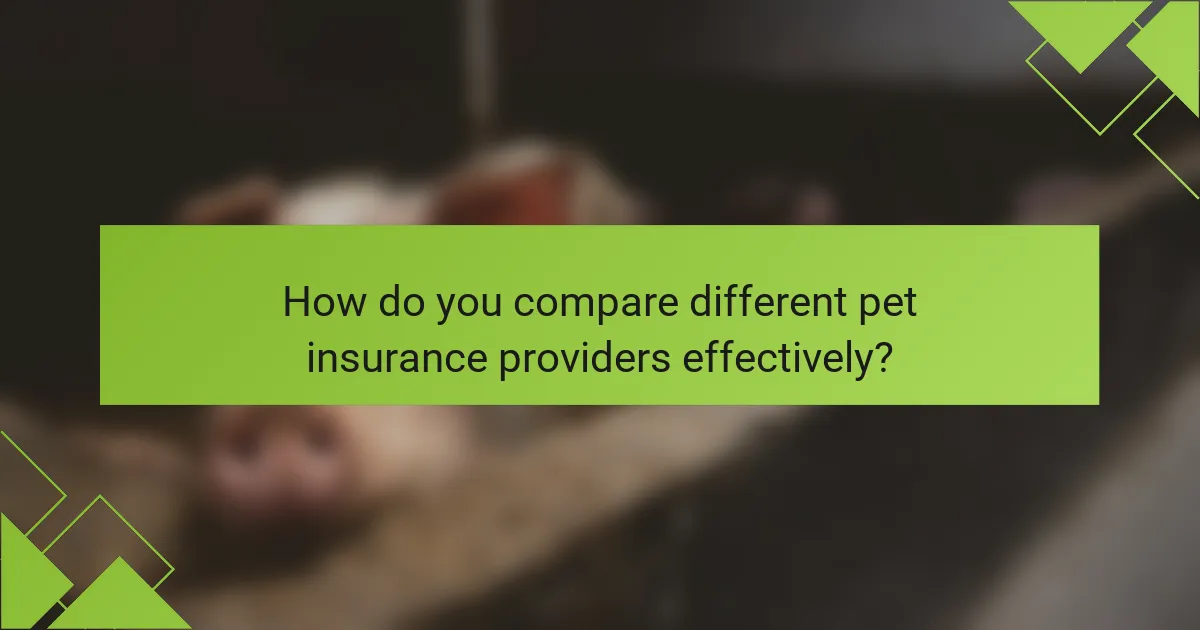Choosing the right pet insurance can protect you from unexpected veterinary costs and ensure your pet receives necessary care. Consider coverage options, premiums, deductibles, and exclusions. Evaluate how your pet’s age, breed, and health history influence your choices. Comparing providers is essential to find the best fit for your needs and budget.

What factors should you consider when choosing pet insurance?
When choosing pet insurance, consider coverage options, premiums, deductibles, and exclusions. Evaluate how these factors align with your pet’s needs and your budget. Coverage should include accidents, illnesses, and preventive care. Premiums vary based on your pet’s age, breed, and health history. Deductibles affect out-of-pocket costs, while exclusions may limit coverage for pre-existing conditions or specific treatments.
How do different coverage options affect your decision?
Different coverage options significantly influence your choice of pet insurance. Comprehensive plans typically offer broader protection, covering accidents, illnesses, and preventive care. In contrast, basic plans may exclude certain treatments or have lower reimbursement rates. Evaluating the specific needs of your pet, such as age and health history, helps determine the most suitable coverage option. Additionally, understanding policy limits and deductibles is crucial for making an informed decision.
What are the common exclusions in pet insurance policies?
Common exclusions in pet insurance policies often include pre-existing conditions, routine care, cosmetic procedures, and certain hereditary conditions. Policies may also exclude specific breeds known for genetic issues and treatments related to aging. Understanding these exclusions helps pet owners choose suitable coverage.

How does the cost of pet insurance vary across different regions?
The cost of pet insurance varies significantly across regions due to factors like local veterinary costs, population density, and insurance provider competition. For example, urban areas typically have higher premiums compared to rural regions. On average, pet insurance can range from £30 to £70 per month, but this can fluctuate based on the specific location and coverage options chosen.
What are the average premiums for pet insurance in Canada, the UK, and the US?
The average premiums for pet insurance vary by country. In Canada, they typically range from CAD 40 to CAD 100 per month. In the UK, average premiums are between £25 and £60 monthly. In the US, pet insurance premiums usually fall between USD 30 and USD 70 per month. These figures depend on factors like the pet’s age, breed, and coverage level.
How do deductibles and co-pays influence overall costs?
Deductibles and co-pays significantly impact overall pet insurance costs. A higher deductible typically lowers monthly premiums but increases out-of-pocket expenses when filing claims. Conversely, lower deductibles raise premiums but reduce immediate costs during veterinary visits. Understanding these dynamics helps pet owners choose a plan that aligns with their financial situation and anticipated veterinary needs.

Which specific needs should you address based on your pet’s age and breed?
Address your pet’s age and breed by selecting insurance that covers age-related health issues and breed-specific conditions. Older pets often require more comprehensive coverage for chronic conditions, while certain breeds may have unique health risks. For instance, larger breeds may need policies that include orthopedic coverage. Tailoring insurance to these factors ensures optimal care and financial protection.
How do pre-existing conditions impact your pet insurance choices?
Pre-existing conditions can significantly limit your pet insurance options. Many insurers may exclude coverage for pre-existing conditions, affecting policy availability and premiums. It’s essential to compare plans that offer coverage for chronic health issues. Some companies provide policies that can cover conditions after a waiting period if they show no signs for a specified duration. Understanding these nuances helps you make informed decisions about the right coverage for your pet’s needs.
What unique risks do certain breeds present for insurance coverage?
Certain dog breeds pose unique risks for insurance coverage due to their predisposition to specific health issues. Breeds like Bulldogs and Rottweilers often incur higher premiums because of their potential for serious medical conditions. Insurers may also impose exclusions or waiting periods for certain breeds, impacting coverage options. Understanding these risks helps pet owners make informed decisions about insurance plans tailored to their pet’s breed and health needs.

What are the benefits of having pet insurance?
Pet insurance offers financial protection for unexpected veterinary expenses. It covers accidents, illnesses, and sometimes preventive care, ensuring that pet owners can afford necessary treatments. Additionally, it provides peace of mind, allowing owners to focus on their pet’s health without financial stress. Some policies even include coverage for alternative therapies, which can enhance a pet’s well-being.
How can pet insurance provide peace of mind during emergencies?
Pet insurance offers peace of mind during emergencies by covering unexpected veterinary costs. This financial support allows pet owners to prioritize their pet’s health without worrying about expenses. Many policies include coverage for accidents, illnesses, and emergency care, ensuring that necessary treatments are accessible. Additionally, having insurance can lead to quicker decisions during critical situations, as owners are not constrained by financial limitations.
What financial advantages does pet insurance offer over time?
Pet insurance offers long-term financial advantages by reducing unexpected veterinary expenses. Over time, it can cover significant costs associated with accidents and illnesses, allowing for budget stability. Many policies also provide preventive care options, which can lead to savings on routine treatments. Additionally, pet insurance can prevent financial strain during emergencies, ensuring pets receive necessary care without delay.

How do you compare different pet insurance providers effectively?
To compare pet insurance providers effectively, evaluate coverage options, costs, and customer service. Focus on the key attributes that matter most to your pet’s needs. Look for unique features such as wellness plans or specific breed coverage. Consider the claim process and customer reviews to gauge reliability. Compare at least three providers to identify the best fit for your situation.
What should you look for in customer reviews and ratings?
Look for transparency, coverage options, and customer service quality in pet insurance reviews. Pay attention to common themes in ratings, such as claim processing speed and customer satisfaction. Unique attributes like specific exclusions or waiting periods can significantly impact your choice. Rare insights, such as long-term customer experiences, provide valuable context for evaluating different providers.
How can you assess the claims process of various insurers?
To assess the claims process of various insurers, compare their claim submission methods, processing times, and customer feedback. Focus on ease of use, transparency, and responsiveness. Look for insurers with straightforward procedures and positive reviews regarding their claims experience.

What are the common pitfalls to avoid when selecting pet insurance?
Choosing the wrong pet insurance can lead to unexpected costs and inadequate coverage. Common pitfalls include overlooking policy exclusions, failing to compare plans, neglecting to read the fine print, and choosing the cheapest option without considering coverage limits. Always assess the specific needs of your pet, such as pre-existing conditions, and ensure the policy aligns with those needs. Additionally, many pet owners forget to evaluate the claims process, which can significantly impact the ease of receiving reimbursements.
How can misunderstandings about policy terms lead to issues?
Misunderstandings about policy terms can lead to significant issues when selecting pet insurance. These misunderstandings may result in unexpected costs or inadequate coverage. For instance, unclear definitions of terms like “pre-existing conditions” or “coverage limits” can mislead pet owners. As a result, they might choose a policy that does not meet their needs, leading to financial strain during veterinary emergencies. Clear communication of policy details is essential to avoid such pitfalls.
What mistakes do pet owners frequently make when choosing coverage?
Pet owners often make critical mistakes when selecting pet insurance, leading to inadequate coverage. Common errors include underestimating their pet’s health needs, overlooking policy exclusions, and failing to compare plans effectively. Many also neglect to read the fine print, resulting in unexpected costs. Additionally, choosing the cheapest option without assessing coverage limits can leave owners unprotected during emergencies. Understanding these pitfalls is essential for making an informed decision.
What best practices can help you maximize your pet insurance benefits?
To maximize your pet insurance benefits, choose a plan that aligns with your pet’s healthcare needs. Review policy coverage, including exclusions and limits. Maintain accurate records of veterinary visits and claims. Regularly communicate with your insurance provider to understand your benefits fully.
